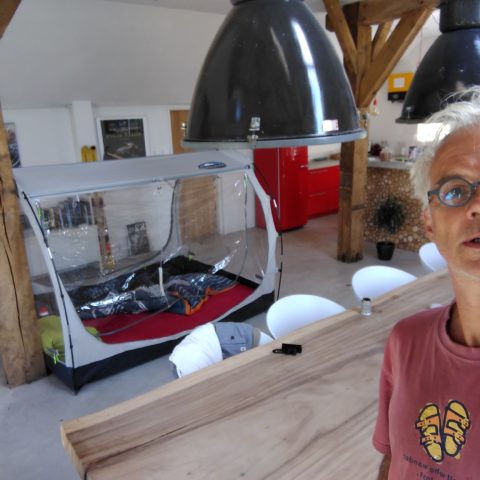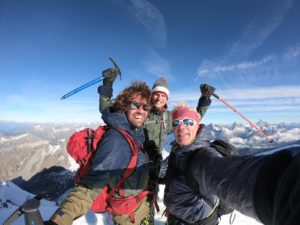
Goal was to climb 2 big 7000-ders in the Pamir mountains of Tajikistan. Namely: Korzhenevskaya peak (7105m) and the Somoni peak (7495m). To be able to do this in 3 weeks, I wanted to try and find out if acclimatization with a so called altitude tent would work. Via Altitude Dream I came in contact with Kristof van Malderen. He is a top athlete himself and has participated in European middle-distance championships. He narrowly missed the Olympic Games.
Through an altitude generator that you connect to your altitude tent, you blow in air with a lower oxygen content. The altitude that you can simulate in steps goes up to a maximum of 4000 metres. After that you would not sleep very well, which of course is the intention before your departure on an expedition. You increase your altitude step by step and faithfully measure your saturation every morning with an oxygen saturation meter that you can easily put on your thumb or finger.
What I noticed with sleeping in the more or less enclosed space is that the temperature immediately rises a little in the high altitude tent and on hot days that means sweating. You lose a lot of moisture and you have to urinate more than usual. A good litre to 1.5 litres was quite normal for me, in addition to the moisture that you evaporate and sweat out during the night. In the beginning, I thought I could skip steps in terms of height, but then the next day I had a slight headache. So advice: don't skip steps too quickly 😉 The trick is of course to keep a regular pattern in terms of sleeping and getting up. The longer you sleep in the tent, the better you acclimatise. Twelve hours a night is better than eight hours but I was happy if I got the eight hours. Sometimes I slept very well but often less and that meant waking up more often at night. I usually turned on the altitude generator an hour beforehand so that I slept at the same height. This is a kind of acute acclimatisation to altitude, which normally takes place in a more gentle manner, so you could also choose to turn on the pump when going to sleep. Keep in mind that you will sleep one hour less at altitude. The trick is also to urinate in the altitude tent using a urine bottle because as soon as you leave the tent your oxygen saturation level rises back to normal, well above 95%. After about 3 weeks I was sleeping at about 4000 metres. During physical training at sea level, I had the idea that I was already benefiting from it. Definitely a few percent. I can't say for sure but I felt physically at my best. Of course, the placebo effect can play a role here.
Unfortunately, after 6 weeks of faithfully sleeping every night in my Altitude Dream high altitude tent at 4000 metres with all its discomforts, the decision was made one week before departure. The country Tajikistan was still in lockdown and so we had to cancel the expedition. A mental blow, but what to do. Promptly there was my quote on the sports and motivation calendar of SportsSpeakers literally on the 8th of July 2020 the day of departure:
"Were there any obstacles on your way?" To which the adventurer replies: "The obstacles were the way!
I decided to use my acclimatisation in the Alps. Finally, I had to find out whether the altitude adaptation experiment using an altitude tent was successful or not. I had always been very sceptical because I have always believed in slow adaptation under one's own power and purely natural and not artificial with a tent connected to a pump to simulate altitude. That is also how I always climb without supplemental oxygen, under my own power 'by fair means'. That is my style and conviction. The headlines on my 2002 Mount Everest expedition already said: "Up that mountain without doping!
The choice of area is easily made. The highest and largest massif in the Alps (not counting the Caucasus) is the Monta Rosa massif and lies above 4000 metres. There I can quickly climb to altitude and also sleep in the highest hut in the Alps, the Margherita hut at 4554 metres. We end up doing the Grande Spagetti Tour there. The climb of 12 mountains of at least 4000 metres plus.
This week is going very well for me. We drive to Switzerland and the next day I go above 4000m and sleep at 3600m in a mountain hut. Normally you can feel that but I have no problems at all. We stay 3 days at an altitude varying between 3600 and 4500 metres and the last night we even sleep at 4550 metres. After that, we climb to a summit of 4633 metres. I really did not suffer from anything. Of course, you don't sleep like you are used to, which is partly due to the altitude, but there was no nausea or headache. Conclusion: it worked for me. It is a pity that I could not have tried it longer at extreme altitude. The only question you have to answer for yourself is whether you can find the discipline to sleep alone in a tent with a pump that unfortunately makes some noise, 6 weeks prior to your expedition (or other top achievement). But hey, you are a (top)athlete or not 😉 .
What is also possible is an active height adjustment. You can do that on an exercise bike, for example.
To be continued! Wilco Van Rooijen

